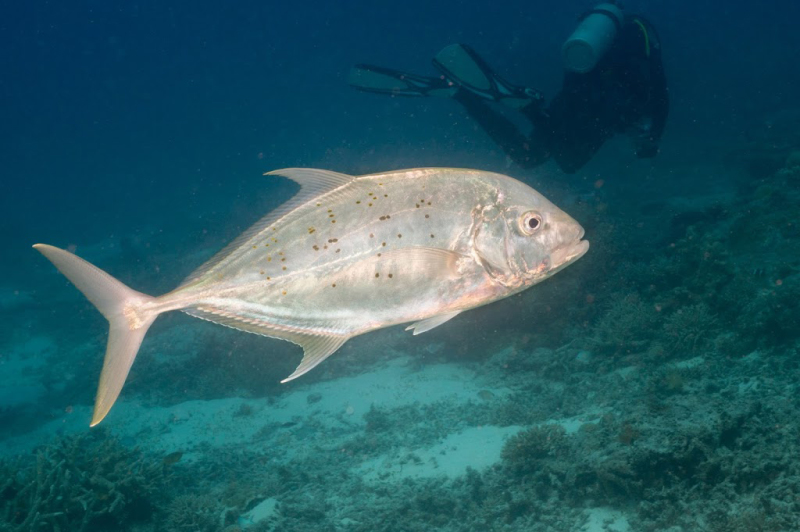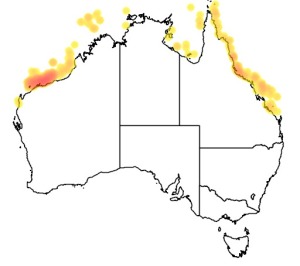Colours
Distinguishing features
As a juvenile, the fish is ovate, becoming more elongated with age, with the convex dorsal profile of the head and nape becoming less steep with age also.
It has an overall silver-green body as a juvenile, while adults have green-blue to olive green body above, becoming more silvery below.
At all stages of its life, the fish has a few brown or golden spots in a midlateral band, but much less than the yellowspotted trevally, while the dusky opercular spot is often inconspicuous.
The dorsal, anal and caudal fins are olive green, with the soft dorsal, anal and anal fins having white lobe tips and the anal having white leading and distal edge. The pelvic and pectoral fins are hyaline to green. (Wikipedia)
Size
- Up to 90 cm (Length of specimen)
Weight
- Up to 14.5 kg
Depth range
- Depth range data is not yet available.
Synonyms
Distribution
Distribution and habitat preferences
It is distributed throughout the tropical to subtropical regions of the Indian and west Pacific Oceans, ranging from South Africa in the west, along east Africa and north to the Red Sea. Its distribution in the Indian Ocean extends east to India, South East Asia, Indonesia and as far south as northern Australia. In the Pacific Ocean, it extends as far north as Japan and out to New Caledonia, Tonga and the Kapingamarangi Atoll.
It inhabits moderately deep offshore waters on rocky and coral reef structures, rarely found in inshore waters. (Wikipedia)
Local abundance
- Lizard Island: Large schools occasionally present at Cobia Hole.
Behaviour
The bludger moves in small schools as a juvenile, becoming more solitary with age. (Wikipedia)
Diet
It has a rather soft mouth and weak jaws, limiting the types of prey available to it, with studies showing prawns, small crabs, mantis shrimps and small fish are its main prey. (Wikipedia)
Web resources
References
- Barton, D.P., C. Beaufrere, J.-L. Justine and I.D. Whittington (2009). Polyopisthocotylean monogeneans from carangid fishes off Queensland, Australia and New Caledonia, with a description of Heteromicrocotyloides megaspinosus, Acta Parasitlogica, 54: 205-217. LIRS catalog number 1255.
- Bray, R.A., T.H. Cribb and S.C. Barker (1993). Hemiuridae (Digenea) from marine fishes of the Great Barrier Reef, Queensland, Australia, Systematic Parasitology, 25: 37-62. LIRS catalog number 484.
- Randall, J.E., G.R. Allen and R.C. Steene (1990). Fishes of the Great Barrier Reef and Coral Sea University of Hawaii Press, Honolulu, Hawaii.



